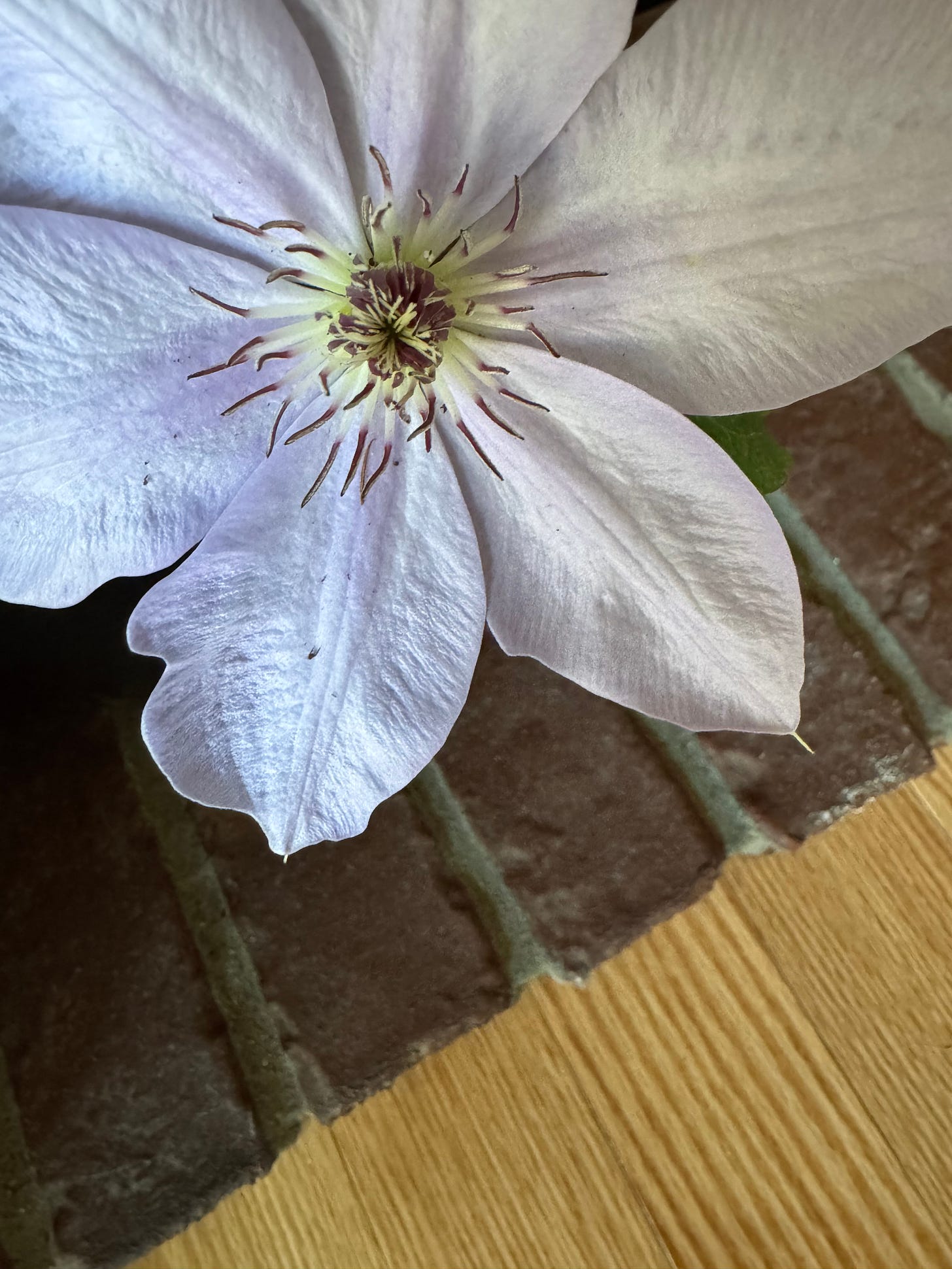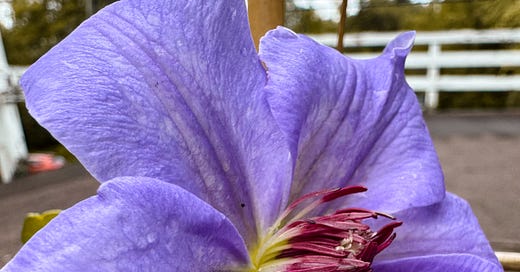Ben bought me a plant for Mother’s Day1 this year.
This isn’t unusual or meritorious of a statement on its’ own; I enjoy pretending I can gardening, removing weeds and wayward grasses, selecting new specimens for beds that I think will survive climate and pests. (Namely, white-tailed deer that have no qualms gorging on any green sprout you don’t want them to consume.)
What marked the selection of this plant, though, was the type of plant: Something we could bring to a new home. We just started our search and I didn’t want to leave his gift in the ground. Especially since we thought we would find the place soon enough.
Together, we picked a clematis: A container-based, flowering plant that stretches to search for the stars but needs a pole or trellis to support its’ ambitions.
And it barely budged all summer.
Clematis (ˈkle-mə-təs). Any of a genus (Clematis) of vines or herbs of the buttercup family often having three leaflets on each leaf and usually white, red, pink, or purple flowers
On the deck (away from the prying eyes and ravenous appetites of hoofed, hungry critters), it roasted. I’d move it to a shaded part of the deck, and it seemed to wither more. Back in the sun, lots of water, brown spots still appearing if I wasn’t diligent with the drink. The wind would knock it over; I’d return it to the pot and try to tether it to the deck rail. Another gust. The green vine only slowly inched along, and nary a bud for the entire summer.
Meanwhile, we were growing frustrated. (Admittedly, with housing being what it is, a privileged position to be in.) House listings constantly catfishing us with glamour shot photos. One place very likely had a dead cat in the walls. Or the imminent beginnings of a Legionnaires’ outbreak. Too big. Too small. We debated becoming landlords. We mused about staying put. We would sometimes ignore the listings and go fishing or birding instead.
Eventually, we went to Scotland for our big adventure. I didn’t need to leave any instructions to water the clematis, mind you; it hung on, stubbornly, to the tiny trellis provided in the container, a few long green shoots now waving in the wind, but not begging for any special treatment. These shoots continued to twist and lengthen, but leaves would still brown in the shade, or become sprayed with tiny tooth marks from a very hungry caterpillar.
We returned from our trip - and just then, with the summer over, a group of large, lavender blue blooms burst like floral supernovas. On Labour Day - long after I gave up, long after I resigned to finding a plant hospice, long at the end of a season that I thought was lost - the clematis bloomed.2
And we resumed our house hunt, finally finding success mid-September.
The blooms were relatively short-lived, but during the packing frenzy they provided grounding moments of peace.
By the time we were ready to move, the plant retracted back to the handful of unassuming vines. I was encouraged, though, by this big bang of colour. Even when all looked lost, it could find a way to thrive. I brought the container of remaining vines (now resembling sticks) and set it on the fireplace of our new home for a long winter’s nap. Hoping it would make it to spring, when I could try again.
But about a week after moving into the new place, I walked into the living room and did a double-take.
Among the unpacked boxes and bare walls, the clematis bloomed again.

This solitary flower, too, lasted a week or so, before taking its’ bow. Yet as the days continued to grow shorter to allow for the nights to lengthen, the vines began to stretch. And stretch. Recently, I moved it next to the Christmas tree, attaching some hooks to guide its’ growth up a bookshelf - next to the window it seems to fancy, where it can watch for the dawn of each new day in agreeable warmth.
And so, I can’t help but think a lot about my clematis these days.
How, when there were days that seemed a little darker, it continued to grow and strive for the light.
And how - as the world seems to grow darker and as challenges rise up and threaten shade - that there may still be a bloom of hope out there, and a way to find the light we need.
As point of reference for my UK friends, this is the second Sunday of May every year.
As a stepmother having received said plant on Mother’s Day, that irony isn’t lost on me.






This is so lovely, Bryn - what a special, special plant that clematis is - such a brilliant metaphor for your move.
I've always wondered why the UK is the odd-one-out with its Mother's Day scheduling. In the rest of Europe, like in the US, Mother's Day is the second Sunday in May. Here it's always on Mothering Sunday in the Christian calendar, on the fourth Sunday in Lent (three Sundays before Easter).